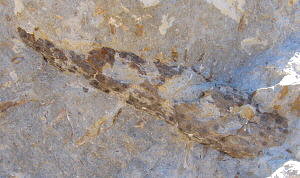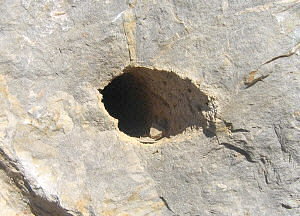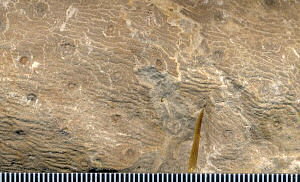Stigmaria sp.
Click on pictures to magnify
Discussion:
Stigmaria is the root structure of lycopod
trees, such as Lepidodendron,
a common Carboniferous plant. The interior of the Stigmaria root was
composed of soft (pith-like) tissue that decayed easily, so most Stigmaria
fossils are sediment-filled casts of the root mold left after the tissue decayed.
This usually preserves details of the surface of the root.
Viewer comments:
These specimens are unusually good, in showing the small rootlets
that grew out from the main root and preserving a ridged surface of
the root. The specimen shown in the upper right photo also shows the
manner in which rapid decay produced a mold of the root within the
surrounding sediment. In this case, the mold remained unfilled with
sediment and the surrounding matrix was quickly cemented so the mold
remained open and undeformed.
The cast shown in the lower left photo has a linoproductid
brachiopod
adhering to it at the right end. (Use the enlarged image to see it properly.)
Details of the shell are well preserved. The brachiopod was in the sediment
that the root grew in, demonstrating that seafloor sediments became exposed
as sealevel dropped and trees soon grew on the exposed sediments. Tree
growth and cementation of matrix occurred quickly, to allow preservation
of both the brachiopod shell
and the root.
Tom Yancey
Site
Search Engine
search Carboniferous fossils of Russia or the Web



